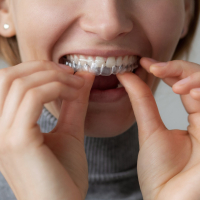
Authors: Conchita Martin, Simon J Littlewood, Declan T Millett, Bridget Doubleday, David Bearn, Helen V Worthington, Alvaro Limones
Key messages
‐ We cannot draw firm conclusions about any one approach to retention over another because we have little confidence in the evidence.
‐ More well‐planned studies are needed. They should measure tooth stability over at least two years, how long the retainers last, patient satisfaction and any unwanted effects from the retainers, such as tooth decay and gum disease.
What is the problem?
Teeth can become crooked again after being straightened with orthodontic braces ('relapse'). Orthodontists try to prevent this using different ways of holding the teeth straight ('retention procedures'). Retention procedures can include wearing custom‐made fixed or removable retainers, usually made of wires or clear plastic, after orthodontic braces have been removed. Removable retainers can be worn full‐ or part‐time. Retainers fit over or around teeth, or stick onto the back of teeth. Orthodontists may also use extra treatments ('adjunctive procedures') such as smoothing contacts between the teeth ('interproximal enamel reduction'), or cutting fibres that connect the gum and the neck of the tooth ('pericision').
What did we want to know?
We wanted to find out the best way to maintain teeth in their new position after the end of treatment with orthodontic braces and whether there are any unwanted effects.
What did we do?
We searched for studies that compared different types of retainers following treatment with orthodontic braces, and that measured the effects for at least three months after the orthodontic treatment. We summarised study results and rated our confidence in the evidence.
What did we find?
We found 47 studies with 4377 adults and children. Most studies took place in hospitals, universities or specialist practices, NHS clinics, or a mixture of places. Most of the studies tested: removable retainers versus fixed retainers; different types of fixed retainers or bonding materials; or different types of removable retainers. Most measured the effects of treatment for less than one year.
Main results
Removable versus fixed retainers (8 studies)
Teeth may return to their previous position more with part‐time wear of a removable retainer made of clear plastic than with a fixed retainer, but the difference was so small that it may not be important. If the removable retainer is worn full‐time, there may be no difference between the retainers in tooth movement. Clear plastic retainers worn part‐time may fail less than fixed retainers, but when worn full‐time may fail more. Better gum health may be achieved with clear plastic removable retainers than with fixed retainers, but no difference was found in tooth decay.
Different types of fixed retainers and glues to stick them on (21 studies)
CAD/CAM (computer‐aided design/computer‐aided manufacturing) nitinol fixed retainers compared to conventional multistrand wire fixed retainers may not differ in terms of how well they hold the teeth straight, gum health, or how long they last.
Fibre‐reinforced composite retainers are less obvious on the teeth therefore participants are more satisfied with them because of their appearance. Fibre‐reinforced composite retainers may be slightly better at keeping the teeth straight, but the difference was so small, it might not be important. Fibre‐reinforced composite retainers might be more likely to fail earlier and be associated with more gum problems than multistrand fixed retainers.
Different types of removable retainers (16 studies)
The effects of Hawley removable retainers compared with clear plastic retainers on movement of the teeth may be similar, whether they are worn full‐ or part‐time. Clear plastic retainers may provide better patient satisfaction but be less likely to last than Hawley retainers.
What are the limitations of the evidence?
Our confidence in the evidence is low because the studies were small and did not use the best methods. Very few studies looked at more than one of the things we were interested in. Most studies measured results less than a year following treatment. Also, we do not know how much study results may be affected by the age of the participants and whether they are still growing, what kind of problems they had with their teeth before their first braces, and what other treatment they had, such as extractions.
How up to date is this evidence
The evidence is up to date to 27 April 2022. This review updates one originally published in 2004 and last updated in 2016.
Read the full updated review of Retention procedures for stabilising tooth position after treatment with orthodontic braces here: https://www.cochranelibrary.com/cdsr/doi/10.1002/14651858.CD002283.pub5/full
